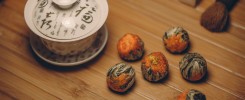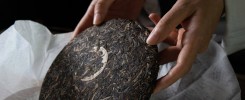For anyone who falls in love with Pu-erh tea, one question eventually arises: How do I store it properly? Unlike green or black tea, Pu-erh is a living tea—it continues to age, evolve, and deepen in flavor long after it leaves the factory. The way you store it can determine whether it matures beautifully or loses its character entirely. As someone who has spent decades sourcing, aging, and selling tea, I can assure you: proper storage isn’t complicated, but it requires understanding and respect for the leaf.
Table of Contents
Understanding Pu-erh: A Living Tea
Pu-erh (普洱茶) from Yunnan, China, is unique because it’s a post-fermented tea. This means it continues to develop flavor and aroma through microbial activity over time. Think of it as similar to aging fine wine or cheese—its environment shapes its evolution.
There are two main types of Pu-erh:
- Sheng (Raw) Pu-erh: Naturally aged over years or decades. Its flavor transforms from grassy and astringent when young to mellow, sweet, and complex with age.
- Shou (Ripe) Pu-erh: Undergoes an accelerated fermentation process before sale, resulting in a darker, smoother tea that’s ready to drink sooner.
Both types benefit from careful storage, but Sheng Pu-erh, especially, thrives under long-term aging conditions.
The Golden Rule: Stable, Clean, and Breathable
If you remember only one principle, let it be this: Pu-erh tea needs a stable, clean, and breathable environment. This is the foundation of good storage.
- Temperature: Keep your Pu-erh in a cool, consistent environment—ideally between 20–30°C (68–86°F). Avoid sudden changes in temperature, as they can stress the tea and slow microbial development.
- Humidity: Relative humidity should stay around 60–70%. Too dry, and the tea stops aging; too humid, and mold will appear. A gentle balance is key.
- Airflow: Pu-erh needs air circulation to “breathe,” allowing natural fermentation to continue. But avoid direct drafts, which can dry the leaves.
- Odor-Free Space: Tea absorbs smells easily, so never store Pu-erh near perfume, spices, or cleaning products. Even wooden cabinets with strong scents can affect its flavor.
- No Direct Sunlight: Store Pu-erh in a dark place. UV light destroys its aromatic compounds and microbial life.
A good analogy is to treat your Pu-erh like fine leather—it appreciates warmth and breathability but hates moisture and sunlight.
Common Mistakes to Avoid
Many tea drinkers unknowingly ruin their Pu-erh by overprotecting it. Here are some traps to watch out for:
- Airtight Containers: Unlike green tea, Pu-erh shouldn’t be sealed off from oxygen. Airtight jars may keep it “fresh,” but they also suffocate the beneficial microbes.
- Refrigeration: Cold temperatures halt microbial activity, stopping the aging process completely. Worse, moisture condensation can destroy the tea.
- Plastic Bags: Over time, plastic releases odors and chemicals that cling to the tea’s surface. Always use paper, cotton, or unglazed clay packaging instead.
- Excessive Humidifiers: Too much humidity creates an environment for mold. If your region is naturally humid, consider using a dehumidifier or silica packs nearby (but not touching the tea).
How to Store Pu-erh at Home
You don’t need a professional aging room to store Pu-erh properly. For most tea lovers, a simple, consistent setup works best.
- Choose a Dedicated Space: A closet, pantry, or wooden cabinet in a quiet corner of your home is ideal.
- Keep It in Original Wrapping: Most Pu-erh cakes and bricks come wrapped in paper for a reason—it allows the tea to breathe.
- Use Clay or Bamboo Containers: Traditional storage vessels, such as Yixing clay jars or bamboo baskets, help regulate humidity naturally.
- Avoid Frequent Handling: The oils from your fingers can affect the tea’s surface. Handle it minimally, especially if you plan to age it for years.
If you live in a particularly dry or cold climate (like northern Europe or the U.S. Midwest), you might place your tea in a small cardboard box with a few ventilation holes. This creates a mini “microclimate” that balances air and humidity.
The Art of Aging: Let Time Do Its Work
Here’s where storing Pu-erh becomes truly fascinating. Properly aged Pu-erh develops woody, honeyed, and camphor-like notes, losing its bitterness while gaining depth and body. Poorly stored tea, on the other hand, tastes flat, dusty, or even sour.
As the tea ages, natural microorganisms transform the leaves, breaking down polyphenols and creating complex aromatic compounds. This is why storage conditions directly shape taste—and why the same batch of tea, aged in different climates, can taste dramatically different after ten years.
For example, “dry storage” (like in Kunming) produces clean, crisp flavors with high aroma, while “humid storage” (like in Hong Kong or Malaysia) creates darker, richer, more earthy profiles. There’s no right or wrong—just preference.
A Fresh Perspective: Let Your Environment Become Part of the Tea
Here’s something few people talk about: your storage environment gives your Pu-erh its unique local signature.
If you age tea in San Francisco, London, or Tokyo, the humidity, air composition, and temperature of that region will subtly shape its flavor over time. In other words, your tea becomes a reflection of your environment—a global tradition reinterpreted through local conditions.
That’s the magic of Pu-erh. It’s not just a product; it’s a living, evolving relationship between tea, time, and place.
Final Thoughts
Storing Pu-erh tea doesn’t require fancy tools—just care, patience, and understanding. Keep it clean, dry, and breathable. Let it rest quietly, away from odors and sunlight. Check it occasionally but resist the urge to interfere.
With the right environment and enough time, your Pu-erh will reward you with layers of aroma and history that no freshly made tea can match.
In a world where everything moves fast, storing Pu-erh reminds us that some of life’s greatest pleasures come from waiting.

